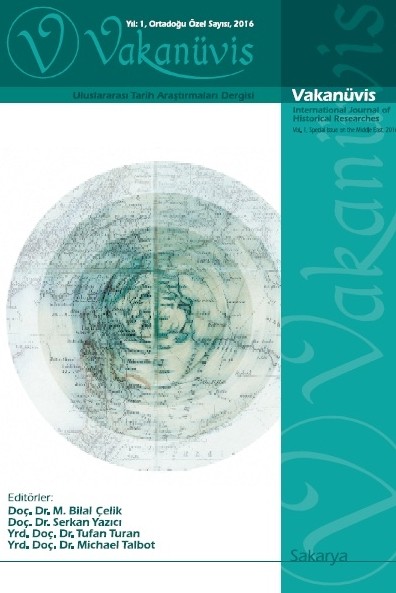Adilşahlar Devleti’ndeki Toprak İdare Sistemine Bir Bakış
Adilşahlar, Hindistan, Toprak İdaresi, Türk, Hindu
A look at the land management system of Adil Shahi Dynasty
Adilshahi, India, Land Administration, Turk, Hindu.,
___
- Altekar, A. S.; State and Government in Ancient India, Motilal Banarsidass, Delhi 1958.
- Burnell, Arthur Coke; The Voyage of John Huyghen van Linschoten to the East Indies, Hakluyt Society, Londra 1885.
- Correa, Gaspar; The Three Voyages of Vasco da Gama and His Viceroyalty from the Lendas da India of Gaspar Correa, Henry E. J. Stanley (çev.), Burt Franklin, New York 1869.
- Cousens, Henry; Bijapur: The Old Capital of the Adil Shahi Kings, Scottish Mission Industries Company, Poona 1923.
- Firişte, Muhammed Kasım; History of the Mahomedan Power in India, Lt.-Col. John Briggs (çev.), R.Rambray&Co., Calcutta 1910.
- Fukazawa, Hiroshi; The Medieval Deccan: Peasants, Social Systems and States (Sixteenth to Eighteenth Centuries), Oxford University Press, Delhi 1991.
- Gribble, J. D. B.; A History of the Deccan, Luzac & Co., Londra 1896.
- Gune, V. T.; Judicial System of the Marathas, Deccan College, Poona 1953.
- Kantak, M. R.; “The Political Role of Different Hindu Castes and Communities in Maharashtra in the Foundation of the Shivaji's Swarajya”, Bulletin of the Deccan College Research Institute. Pune 1978, 38 (1).
- Khare, G. H. (ed.); Persian Sources of Indian History, Bharat Itihas Sanshodhak Mandal, Poona 1934.
- King, Major J. S.; The History of the Bahmani Dynasty Founded on the Burhan-i Ma’asir, Luzac and Co., Londra 1900.
- Kortel, S. Haluk; "Tuğluklular", TDV İslâm Ansiklopedisi, https://islamansiklopedisi.org.tr/tugluklular (25.08.2023).
- Lach, Donald F.; Asia in the Making of Europe, The University of Chicago Press, Londra 1965.
- Mookerji, Radha Kumud; Local Government in Ancient India, Clarendon Press, Oxford 1920.
- Nayeem, M.A.; External Relations of the Bijapur Kingdom (1489-1686 AD.), Bright Publishers, Haydarabad 1974.
- Nizami, Khaliq Ahmad; "Evrengzîb", TDV İslâm Ansiklopedisi, https://islamansiklopedisi.org.tr/evrengzib (25.08.2023).
- Pires, Tome; The Suma Oriental of Tome Pires, Armando Cortesao (ed.), Hakluyt Society, Londra 1944.
- Purandare, K. V. (ed.); Shiva Charitra Sahitya, Prastavana, Poona 1938.
- Robb, Peter; A History of India, Palgrave, Londra 2002.
- Sevim, Ali & MERÇİL, Erdoğan; Selçuklu Devletleri Tarihi: Siyaset, Teşkilat ve Kültür, Türk Tarih Kurumu Yayınları, Ankara 2014.
- Sewell, Robert; A Forgotten Empire (Vicayanagar), Swan Sonnenschein & Co. Ltd., Londra 1900.
- Smith, Vincent A.; The Early History of India: From 600 B.C. to the Muhammadan Conquest, Clarendon Press, Oxford 1904.
- Thorner, Daniel; “Feudalism in India”, Feudalism in History, R. Coulborn (ed.), Princeton University Press, Princeton 1956.
- Uzunçarşılı, İsmail Hakkı; Osmanlı Tarihi, Türk Tarih Kurumu Basımevi, Ankara 1982.
- Wilson, H. H.; A Glossary of Judicial and Revenue Terms, W. H. Allen and Co., Calcutta 1940.
- ISSN: 2149-9535
- Başlangıç: 2016
- Yayıncı: Serkan YAZICI
Elvan ATAMTÜRK, Turgay ÇAVUŞOĞLU, Mehmet Zafer DANIŞ
Son Dönem Osmanlı Bilim Kurullarına Bir Örnek: Tedkikat-ı Lisaniye Heyetinin Kuruluşu ve Çalışmaları
Adilşahlar Devleti’ndeki Toprak İdare Sistemine Bir Bakış
NATO Kuvvetler Statüsü Sözleşmesi (SOFA) Ve Yarbay Morrison Davası
Bilecik’in Fethinin Osmanlı Kuruluş Tarihi Açısından Önemi
19.Yüzyıldan Günümüze Torbalı’nın Köyleri İle Sınırlarında Meydana Gelen İdari Değişiklikler
Osmanlı İnşaat Mühendisliğine Bir Örnek: İstanköy Limanı Çalışmaları (1850-1909)
